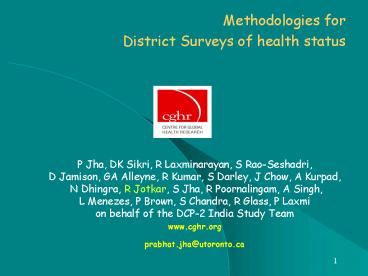Methodologies for PowerPoint PPT Presentation
1 / 14
Title: Methodologies for
1
- Methodologies for
- District Surveys of health status
P Jha, DK Sikri, R Laxminarayan, S Rao-Seshadri,
D Jamison, GA Alleyne, R Kumar, S Darley, J
Chow, A Kurpad, N Dhingra, R Jotkar, S Jha, R
Poornalingam, A Singh, L Menezes, P Brown, S
Chandra, R Glass, P Laxmi on behalf of the DCP-2
India Study Team www.cghr.org prabhat.jha_at_utoron
to.ca
2
- Outline
- Rationale of District Indicators
- Background of District survey
- Consultative Process for District survey
conforming to DISHA - Output of Consultative Process
- DISHA for reducing MMR
- DISHA for reducing U5MR, especially that of
female - DISHA for reducing Premature Adult mortality
(16-59 yrs) - DISHA for Disease specific reform
- DISHA for System wide reform
- Indicators for outcome, service use, household
determinants, financial risk protection, public
responsiveness - Revised Survey Tool envisaging the indicators
conforming to the DISHA - Possible Future course
3
- District Level Health Indicators
- Rationale
- For monitoring district wise outcome and coverage
of various health programs by Central/State
Governments. Pre-requisite in the era of
de-centralized planning. - Honble Prime Ministers desire to undertake and
publish District Level Annual Health Indicators
regularly and compare against benchmarks. - ORGI plan to cover all Indian districts (593) in
3 phases in order to restrict effective sample
size to 39000 population or 7200 eligible women
or 7000 households per district. Thus each
district would be covered once in 3 years.
4
- Sample Size Criteria
- The sample size would depend upon
- Choice of the decisive indicator
- Birth Rate/Death Rate/Infant Mortality Rate
- Permissible Level of Error
- 5/10/15 percentage relative standard error
- Level of Aggregation
- National/State/District
- Periodicity and Reference Period
- 1/2/3 years
5
Sample Size (Population) at varying rates of
Infant Mortality Rates and Birth Rates at 10
percent relative standard error (prse)
Population in 000
6
- Periodicity of events Vs
- Population covered
- (Level of error 10 prse of IMR)
Note Sample size estimated for a district with
birth rate of 25 and infant mortality rate of 60.
7
Expected District Indicator Outcome
- -
8
Expected District Indicator Output
- -
9
Expected District Indicator Output
- -
10
Expected District Indicator Output
- -
11
Expected Health determinant inOutcome Indicator
- -
12
Possible Concerns regarding District Health
Indicators
- Experience with SRS health check up reveals
under-reporting of adult deaths by about 13 and
it was marginally higher for female adults. Newer
SRS sample frame of 2001 might resolve this
partly. - Exclusion of death of in-migrated could be
feasible option in view of earlier experience. - Seasonal Out migration of impoverished people
could reduce validity of adult deaths. - Matching of response rate of tobacco use in
Specific Fertility and Mortality Survey (SFMS)
with NFHS revealed that SFMS underreports the
risk factor. - Matching of response rate of alcohol use in
Specific Fertility and Mortality Survey (SFMS)
with NFHS revealed high correlation of the risk
factor (r .0.92)
13
Deliverables within 5 years
- GOAL Increase use of effective health services
(by year 3) and show reductions in mortality (by
year 5) - Prioritization and focus of 5-10 districts on
most effective interventions - Increased allocation of state budgets for health
in intervention states - Accelerated reform (focusing on actions against
specific constraints) in intervention states - Training materials and critical mass of DCP-2
implementers in place in various states and
levels - Rigorous evaluation of new interventions measles
plus antigen program maternal mortality
polypill for CVD - Quantity of cost information dramatically
improves - Put in place simple monitoring system with RGI
- Report cards for each Member of Parliament
produced
Notes Logical framework has been developed
with indicators for specific diseases
14
Thanks

